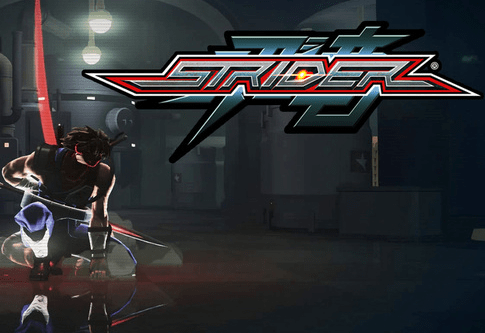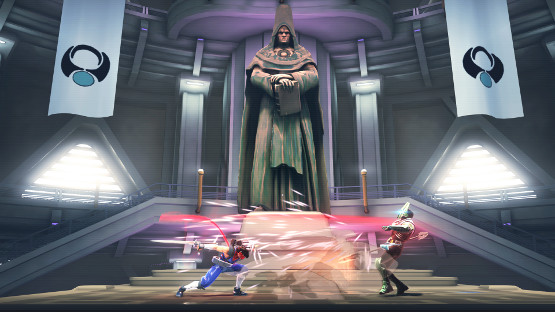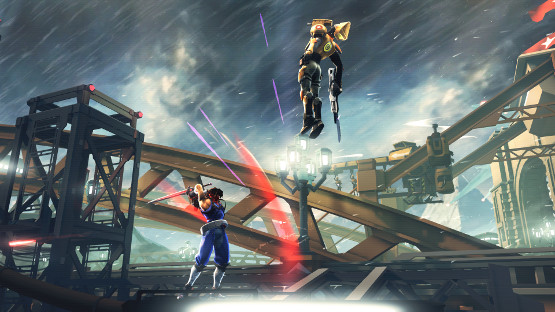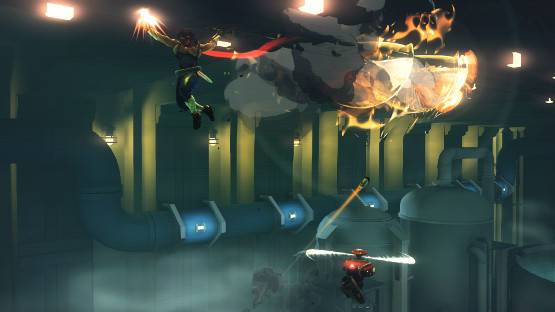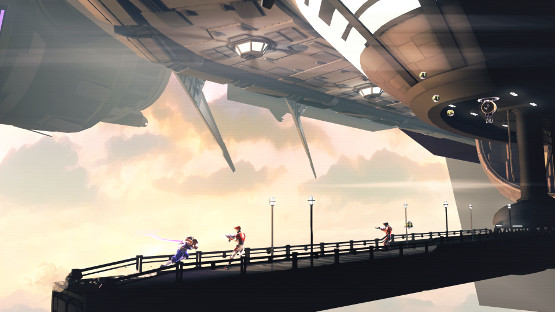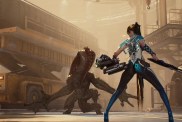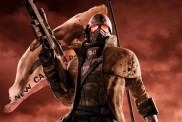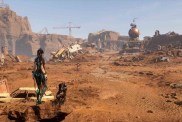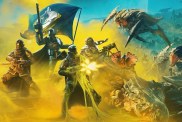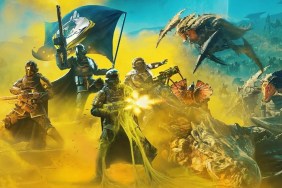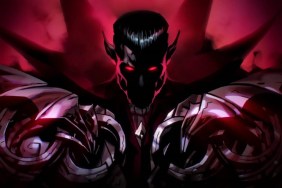Strider is a game designed to be badass. The lead protagonist, Strider Hiryu, is a ninja who wields a plasma-generating cypher, has a plasma scarf, and his short glimpses of personality evoke the Batman. That’s video game alchemy for a winning formula. And the term cypher? That’s just how sword is spelled in the language of awesome. Strider features good graphics, fast combat, and side-scrolling exploration similar to the Metroid or the PS1/DS Castlevania games. Again, Alchemy for an excellent game. So where does Strider stand?
The plot is unchanged from the original games. A powerful man named Meio has taken over the world and has built an evil robotic empire that looks really Communist; right down to the Budenovka headwear on each robotic soldier. Strider Hiryu’s goal is to cripple the military and assassinate Meio. Characterization is simple: Hiryu’s a badass, bosses are sworn Meio loyalists, and Meio has a god complex. It’s not just the enemies who are stuck in the ’80s, either. The above plot was taken from the equivalent of the in-game instruction manual.
The game is broken up by zones, and Hiryu must fight his way to a marked destination. Along the way there are additional power ups such as health, energy, and weapon upgrades to be found. Players will also find power ups to help with traversal, which in turn will open up more of the area and its secrets. Secrets are not just limited to boosting Hiryu’s abilities. Artwork, info on enemies and characters, and palette-swapped costumes are available to find in the levels as well. It is the out-of-game items which will test the player’s desire to explore – the power ups are relatively easy to find in comparison. Many power ups were found practically along the way. Exploration is further enhanced by Hiryu’s fantastic ability to climb just about anywhere.
Combat is fast, and the options available to fight enemies increases as players find more upgrades. By the end of the game Hiryu can reflect bullets, freeze enemies, throw daggers, and summon support for quick attacks. Combining these attacks is one of Strider’s strong points, as just attacking with Hiryu’s cypher is a long and daunting process, especially in boss fights. Hiryu’s ability to climb can be made part of combat as well. Sometimes – not often – players are able to engage in stealth maneuvers for a free first hit on enemies.
If combat is good, it should stand to reason the boss fights are good as well. Sadly, this is not always the case. Many boss fights feel mechanical. Simple pattern memorization and little skill are needed to beat the majority of the bosses. A few fights in the game will showcase Strider‘s action, but most boss fights tend to be boring. More importantly, there’s little balance between the difficulty of regular enemies and the bosses. The bosses seem much easier than the regular enemies. Hard mode is recommended for players looking for a challenge, but bear in mind a lot of that challenge will come from the regular enemies.
Many times combat will combine the action with Hiryu’s ability to climb any surface. This works well most of the time, but there are times when Hiryu sticks to walls too readily. A level featured a laser grid to be outrun by Hiryu. Because of the way the game works, Hiryu would often stick to the ceiling or side of a wall and not let go. Making jumps in tight spaces became problematic – get too near a wall and suddenly the jump is messed up. A separate button for climbing or a double-tap would have been a better set up than the auto-climbing featured in the game. Even in combat this problem would rear its head and a what should have been a good attack turns to a failed attempt.
There seems to be a disconnect between the controls and sub-directions of NW, NE, SW, and SE. The game will occasionally muck with gravity, and moving around on planetoids or around a curved room became a pain. Controls would sometimes assume Hiryu wanted to crouch in a hail of bullets instead of walking around an object. Strider features its fair share of curved and angled surfaces, so this is problematic.
The game is very nice to look at, though some slowdown occurs when too many bullets are on screen and the first time Option-C is summoned in an area. The audio is good, but many tracks end just as the music starts to get good. The voice acting runs from mediocre to a little awful. Cinematics are great – Hiryu poses everywhere and knows how to make both entrances and escapes. The artwork found in the game is terrific. The unlockable extras are nice, and include stages for the two challenge modes found in the game: a wave-based enemy mode and beacon runs, where Hiryu must race through checkpoints for the best time. Both a score-based affairs and have no impact on the main game. In terms of trophies, Strider will probably be an easy platinum for many people.
Strider has a solid foundation. The formula is there, but it needs a lot of tuning. The climbing feature should have been better executed in regards to combat, and climbing gets in the way when the game requires players to hurry. The boss fights lack action, and while the last boss has lots of attacks filling the arena; the fight itself is just tedious. When combined with the aforementioned control issues the last fight becomes annoying. By the end of the game I was left with the impression Strider could have been a lot better. Still, this is an above average title for what Strider does do – provide action and wall climbing.
Review copy provided by publisher.
-
Hiryu can explore just about everywhere
-
Combat delivers when on level ground or in the air
-
Lots of items and unlockables to find
-
Regular enemies can be a challenge without overwhelming
-
Stick to walls less, Spider Strider.
-
Controls need adjusting, especially when faced with non-cardinal directions
-
Boss fights lack challenge
-
Zombie-like enemies and moving laser grids? Yes, Capcom; you made Resident Evil. I got it.
